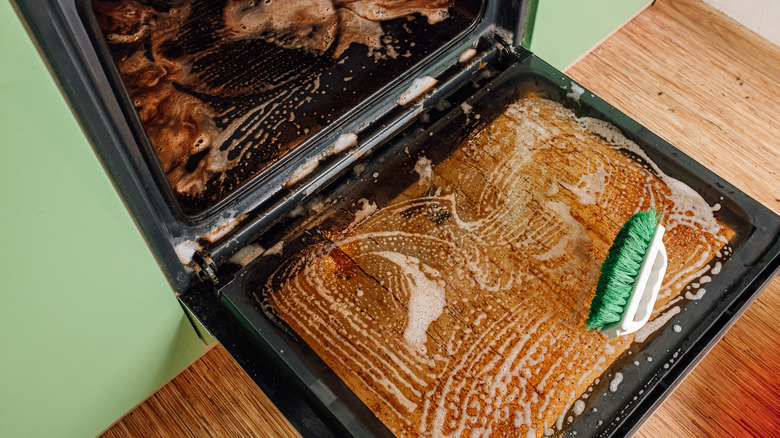Why It's A Mistake To Clean A Warm Oven
Cleaning your oven is part of essential kitchen maintenance. An oven coated in charred food and grease can affect cooking efficiency, diminish the quality of your favorite dishes, and produce unwanted smoke and fire hazards that disrupt the rhythm of your home's beating heart — the kitchen. On average, a moderately used oven can benefit from a deep clean every three months. Cleaning an oven isn't a terribly tricky task and is easily and swiftly achieved with the right tools and supplies. But just because it's a routine chore doesn't mean mistakes are impossible to make. In fact, they're more common than you might think. But among the many mistakes you may be making when cleaning your oven, one of the most dangerous is cleaning it while it's still warm or hot.
Many commercial oven cleaners contain strong chemicals like ammonia, lye, and volatile organic compounds (VOCs) that, when exposed to higher temperatures, can produce toxic vapors that irritate the respiratory system and disrupt your indoor air quality. Heat accelerates the evaporation of VOCs, increasing their concentration in the air and heightening the risk of inhalation-related health effects. Even "natural" cleaners like vinegar and baking soda solutions can irritate the respiratory system. From a practical standpoint, the faster these cleaning solutions evaporate, the faster they leave your oven's grimy surface, which reduces their effectiveness.
Scrubbing a warm oven also increases the chance of burns, as lingering heat from the walls, racks, or glass can cause serious injuries to your skin. If you're cleaning a gas stove, compounds in your cleaning solutions may react with residual gas, which can cause fires and explosions.
The safest way to clean your oven
To reduce indoor air pollution, decrease the risk of respiratory distress, and prevent injury, let your oven cool completely before cleaning. Always wear masks and gloves when handling commercial cleaners to avoid contact with harmful chemicals. While these products are effective, they can still pose a risk, so it's always better to err on the side of caution to protect your skin and respiratory system. Even if you're using natural cleaning solutions, it's still advisable to wear protective gear. Make sure to clean all areas of the oven, including the walls, racks, and door. Before you begin, remove any pots, pans, and any items that may be stored inside.
Although it may sound counterintuitive, avoid using your oven's self-cleaning function. Convenient as it may be in the short term, an oven's self-cleaning function exposes the oven to extreme temperatures that can damage its internal components. The process can also produce harmful fumes, including carbon monoxide, and create a fire risk if excessive grease has built up inside. Instead, clean your oven manually (there are a number of oven-cleaning hacks you can try)at a safe temperature using appropriate tools and taking care to follow safety guidelines to ensure a thorough, safe, and effective cleaning experience.

